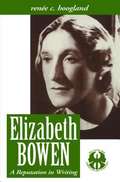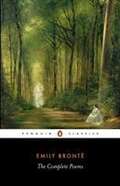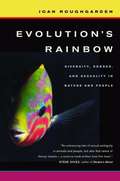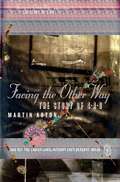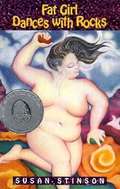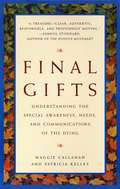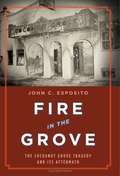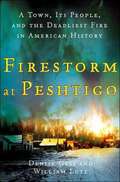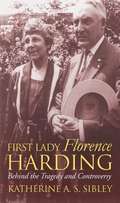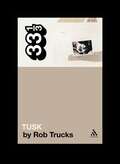- Table View
- List View
Election Journal: The Political Events of 1987-1988
by Elizabeth DrewThe Presidential election of 1988 changed Presidential politics, in ways that will be with us for a long time. New techniques, ans a new tone, were employed, and since they were successful, they are likely to be emulated throughout our political system.
Elizabeth Bowen: A Reputation in Writing
by Renee C. HooglandImmensely popular during her lifetime, the Anglo-Irish writer Elizabeth Bowen (1899-1973) has since been treated as a peripheral figure on the literary map. If only in view of her prolific output--ten novels, nearly eighty short stories, and a substantial body of non- fiction--Bowen is a noteworthy novelist. The radical quality of her work, however, renders her an exceptional one. Surfacing in both subject matter and style, her fictions harbor a subversive potential which has hitherto gone unnoticed. Using a wide range of critical theories-from semiotics to psychoanalysis, from narratology to deconstruction-this book presents a radical re-reading of a selection of Bowen's novels from a lesbian feminist perspective. Taking into account both cultural contexts and the author's non-fictional writings, the book's main focus is on configurations of gender and sexuality. Bowen's fiction constitutes an exploration of the unstable and destabilizing effects of sexuality in the interdependent processes of subjectivity and what she herself referred to as so-called reality.
Emily Jane Brontë: The Complete Poems (Classics Ser.)
by Emily Brontë Janet GezariFor this new edition Janet Gezari has arranged the poems as nearly as possible in chronological order of composition, printing the published texts of the 1846 poems but otherwise taking the most recent manuscript versions. She also provides a scholarly introduction and extensive textual and contextual annotations to the poems.
Every Mother's Son: The Role of Mothers in the Making of Men
by Judith ArcanaIs it possible for us to bring up boys in a non-sexist way? That's the question at the core of this groundbreaking book. During the first ten years of her son Daniel's life, Judith Arcana kept a journal in which she recorded her experiences as a mother -- specifically as a mother of a boy. Drawing from her journal and from interviews with sixty mothers and sons, Arcana presents a compelling examination of male socialization and the role of women in raising sons.
Everyone's Dead But Us
by Mark Richard ZubroTenth Tom and Scott mystery; on vacation the two men find themselves solving the murder of the owner of the resort they are staying in.
Evolution's Rainbow: Diversity, Gender, and Sexuality in Nature and People
by Joan RoughgardenA celebration of the enormous diversity of genders and sexuality found in animals and among human cultures. Roughgarden explores how and why this range of bodies and behaviors evolved and exposes how biology, medicine, anthropology and Christianity have obstructed the recognition and acceptance of this diversity.
FDR's Splendid Deception
by Hugh Gregory GallagherFocuses on FDR's disability and the lengths gone to to conceal it from the world.
Facing the Other Way: The Story of 4AD
by Martin AstonFACING THE OTHERWAY: THE STORY OF 4AD is the first comprehensive account of the iconic record label. Drawing on over a hundred interviews with the label’s menagerie of artists and staff, music writer and 4AD aficionado Martin Aston follows the course of the label’s defining years; initially populated by the likes of Bauhaus, The Birthday Party, Cocteau Twins, This Mortal Coil and Dead Can Dance, each band resembled a new genre on its own, before 4AD embarked on a new era with a wealth of equally startling American signings, including Throwing Muses, Pixies and The Breeders. Yet for every artistic triumph, there was a backlash. Behind the scenes, an accumulation of feuds and enforced commercial compromises in the wake of alternative music’s invasion of the mainstream left 4AD adrift and Watts-Russell a broken man, soon to sever all ties with the music industry, including his beloved label. This definitive history explains why 4AD has been called the greatest independent label of all time, one of the most influential, and certainly the most collectable. The story of 4AD is an unparalleled drama from a pivotal phase in independent music culture.
Faith For Beginners: A Novel
by Aaron HamburgerIn 2000 a woman travels with her ailing husband and one of her two gay sons to Israel.
Fallen From Grace (Helen Black Mysteries #6)
by Pat WelchWhen Leslie Merrick falls to her death from a window, the verdict is suicide. But Helen Black discovers the corporation she worked for is rife with tensions and treacheries. Could she have fallen accidentally?Or is Helen being set up to take the fall?
Falling To Earth: A Novel
by Elizabeth BrownriggA lesbian whose work has taken over her life is visited by a guardian angel.
Families Like Mine: Children Of Gay Parents Tell It Like It Is
by Abigail GarnerWritings from adult children of gay and lesbian parents.
Family Values: Two Moms and their Son
by Phyllis BurkeA beautifully written memoir of the author's fight to legally co-parent her lesbian lover's child--an inspiring story of love, liberation, and family values. Set against the background of the San Francisco lesbian-gay civil rights struggle, Burke's uplifting portrait of her nontraditional family will deeply touch readers.
Fat Girl Dances With Rocks
by Susan StinsonIt's the summer of drinking and driving, disco and diets, fake IDs and geology, and fat 17-year-old Char is wondering if she is animal, vegetable, or mineral. What does it mean when your best friend French-braids your hair, kisses you on the lips, and leaves town? Char gets a summer job in a nursing home, and meets people with bodies and abilities as various as the textures of the rocks her friend Felice collects. Fat Girl Dances with Rocks is a novel about the many shapes of beauty: the fold of a belly, the green swelling of seedlings, the sharp edges of granite, obsidian, and flint. Fat Girl Dances with Rocks is a coming of age story. It is a coming out story, and for Char, it is a story of coming into her own body - all the way to the edges of her skin.
Faultline
by Sheila Ortiz TaylorWitty novel about a lesbian mother with six children, three hundred rabbits, and a relaxed attitude.
Final Gifts: Understanding The Special Awareness, Needs, and Communications of the Dying
by Patricia Kelley Maggie CallananThe authors provide a compassionate and readable book to help both those who are dying and those who are providing care for them. The authors (hospice workers) gently address common stages experienced by those who are terminally ill. A highly useful book.
Finding H.F.
by Julia WattsAbandoned by her mother and raised by her loving but religiously zealous grandmother, 16-year-old Heavenly Faith Simms (H.F. for short) has never felt like she belonged anywhere. When she finds her mother's address in a drawer, she and her best friend, Bo, an emotionally repressed gay boy, hit the road in Bo's scrap heap of a car and head south. Their journey through the heart of the American South awakens both teens to the realization that there is a life waiting for them that is very different from what they have known and that the concept of family is more far-reaching than they had ever imagined.
Fire in the Grove: The Cocoanut Grove Tragedy and Its Aftermath
by John C. EspositoOn Saturday night, November 28. 1942, Boston suffered its worst disaster ever. At the city's premier nightspot, the Cocoanut Grove, the largest nightclub fire in U.S. history took the lives of 492 people—nearly one of every two people on the premises. It spread through the overcrowded club with breathtaking speed. In a mere eight minutes anyone left inside was either dead or doomed. Against the backdrop of Boston politics, cronyism, and corruption, author John C. Esposito re-creates the drama of the fire and explores the public outcry that followed. In retelling the horrific events of one of America's most cataclysmic tragedies, Esposito has fashioned both a gripping narrative and a vibrant portrait of the era.
Firestorm at Peshtigo: A Town, Its People, and the Deadliest Fire in American History
by Denise Gess William LutzA riveting account of a monster firestorm - the rarest kind of catastrophic fire - and the extraordinary people who survived its wrath. On October 8, 1871 - the same night as the Great Chicago Fire - an even deadlier conflagration was sweeping through the lumber town of Peshtigo, Wisconsin, 260 miles north of Chicago. The five-mile-wide wall of flames, borne on tornado-force winds of 100 miles per hour, tore across more than 2,400 square miles of land, obliterating Peshtigo in less than one hour and killing more than 2,000 people. Firestorm at Peshtigo places the reader at the center of the blow-out. Through accounts of newspaper publishers Luther Noyes and Franklin Tilton, lumber baron Isaac Stephenson, parish priest Father Peter Pernin, and meteorologist Increase Lapham - the only person who understood the unusual and dangerous nature of this fire - Denise Gess and William Lutz re-create the story of the people, the politics, and the place behind this monumental natural disaster, delivering it from the lost annals of American history. Drawn from survivors' letters, diaries, interviews, and local newspapers, Firestorm at Peshtigo tells the human story behind America's deadliest wildfire.
First Lady Florence Harding: Behind the Tragedy and Controversy
by Katherine A. S. SibleyFlorence Kling Harding has come down through history as one of our most scorned first ladies. Victimized by caricatures and branded a shrew, she stands at the bottom of historians' polls, her reputation tarnished by her husband's scandals despite their joint popularity while in office. These depictions, argues Katherine Sibley, have prevented us today from seeing how innovative a first lady Florence Harding really was. This new look at Mrs. Harding restores humanity to an oft-maligned figure by examining her progressive causes, her celebrity, and her role in her husband's work. For if Eleanor Roosevelt is credited with shattering the first lady's ceremonial mold, it was Florence Harding who made the first cracks. Sibley's is the first book to offer a full treatment of Florence as first lady rather than as mere supporting actress in the Harding administration. Never shying from publicity, she made herself more available to the press than did her predecessors and opened the White House up to the public. And she took such a pioneering role in Warren Harding's campaign and presidency that many thought she outdid her husband as a politician. Turning to primary sources that others have overlooked, Sibley challenges the clichés about Florence's time in the national spotlight. She describes how Mrs. Harding supported racial equality, lobbied for better treatment for veterans and female prisoners, and maintained a lifelong interest in preventing animal cruelty. As adviser to her husband, she assisted with his speechwriting and consulted with the cabinet; she was also the first first lady to deliver spontaneous speeches while traveling with the president. At a personal level, Sibley examines in detail how Mrs. Harding responded to her husband's death, assessing why this tragedy struck Americans with such force even as national empathy proved so fleeting. She also offers a more nuanced description of the president's philandering, viewing Nan Britton's claims with skepticism while noting the effects on Florence of his dalliance with Carrie Phillips. Florence Harding bequeathed an activist legacy, and it is due to her example that aspiring presidential wives are expected to campaign with their husbands and be accessible to public and press. Florence Harding truly set the stage for those to follow; this book delivers the full and fair portrait that has long been her due.
Fleetwood Mac's Tusk (33 1/3 Ser. #77)
by Rob TrucksAfter Rumours became the best-selling single album of all-time, Fleetwood Mac asked Warner Brothers Records to buy them a studio (the label refused, costing both Warner Brothers and the band significant cash in the long run) and then handed the reins to their guitarist and resident perfectionist Lindsey Buckingham, a fusion of factors that led Tusk to become the first record in history to cross the million dollar threshold in production costs. “You know,” Buckingham told me, “we had this ridiculous success with Rumours. And at some point, at least in my perception, the success of that detached from the music, and it was more about the phenomenon. We were poised to do another album, and I guess because the axiom 'If it works, run it into the ground’ was prevalent then, we were probably poised to do Rumours II. I don’t know how you do that, but somehow my light bulb that went off was, ‘Let’s just not do that. Let’s very pointedly not do that.’” Here, Rob Trucks talks to Lindsey Buckingham, as well as members of Animal Collective, Camper Van Beethoven, the New Pornographers, Wolf Parade, the Fleetwood Mac tribute band. Tusk, and the USC Trojan marching band in order to chart both the story and the impact of an album born of personal obsession and a stubborn unwillingness to compromise.

